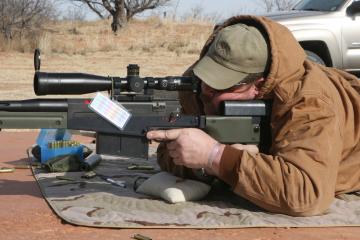
 Don't get too caught up in equipment; there is no substitute for practice. A skilled shooter who knows
his data and rifle will win the day.
Reticle choice can be a matter of personal preference, but the reticle needs to provide an
uncluttered sight picture and not obscure the target. Since the reticle may be used solely, or in
conjunction with the elevation and windage knobs, to specify range hold-over and wind correction, it
should have marks at regular intervals. These demarcations often take the form of mil-dots or hash
marks. Since both the reticle and the elevation and windage knobs specify angular distances, it is
important that the "units" match. If the reticle has mil-dots or mil hashes, then the knobs should
use 0.1-mil clicks. If the reticle has MOA-based demarcations, then the knobs should use 0.25 or
0.50 MOA clicks. When the units match, there is no math required to convert between using one or
the other, and aiming corrections can be done with either the reticle, the knobs, or a combination.
The reticle marks used for elevation and windage hold-off should be close enough to provide useful
intervals, but not so close as to cover parts of the target. For windage and elevation, marks at
1/2 mil or 2 MOA work well.
The next set of attributes have to do with optical characteristics of the scope. The clarity or
resolution of the scope is determined by the quality of lenses and their coatings. Image brightness
and low-light performance are determined by lenses, coatings, and the objective lens diameter versus
the magnification. The exit pupil is the size of the image coming out of the ocular lens. (Ocular
means it's the lens closest to your eye.) If you look at the ocular lens of a scope from a foot or

 The S&B 5-25x56 mm scope is a good choice for extreme range rifles like this Accuracy International
.50 BMG; it looks almost proportionately sized on this rifle.
more away, you will see a small area of transmitted light surrounded by black. This is the exit
pupil. A larger exit pupil can provide a brighter image to the eye. The maximum size of the human
eye's pupil is about 7 mm, so a scope exit pupil larger than that size has no additional benefit in
low light. One advantage of a larger exit pupil not often mentioned is that a larger exit pupil
gives more flexibility in eye position to see a full size picture. This is helpful because small
head movements do not create the black fringe in the scope view. The other benefit is that it is
easier to retain the sight picture through recoil so the shooter can spot his own bullet impacts.
Long-range optics have to provide a mechanism to precisely specify elevation hold-over to compensate
for bullet drop past the rifle's primary zero. This can be done by using demarcations in the
reticle, by dialing an elevation knob, or by using a combination of those two methods. Reticle
design to specify elevation can be as simple as a mil-dot, or as complicated as the Horus H-25
reticle, which has small hash marks every fifth of a mil. Elevation knobs have several properties
we care about: click size, total travel, and if it has a zero-stop. For practical long-range
shooting, a click size of 0.25 - 0.50 MOA, or 0.1 - 0.2 mil is appropriate. Some target scopes have
eighth MOA clicks which are too fine because you'd need 250 clicks to get a 308 to 1000 yards! To
emphasize the importance of this point again- the reticle and the knob clicks should be in the same
units system: MOA and MOA, or mils and mils!
|